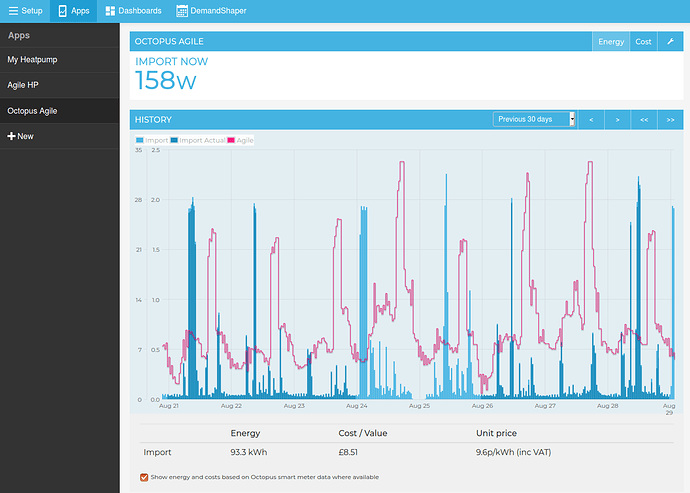I’ve added support for integrating Octopus smart meter consumption data where available in the app *. If the smart meter data is available it will show the half hours as shaded darker blue, otherwise it shows the half hourly consumption from the main feed, recorded via the emonTx/emonPi or other hardware that you may be using.
If the checkbox is ticked at the bottom of the page, it will calculate the total consumption and total costs based on the smart meter data where available.
Now that Im on the tariff (since just over a week!) I wanted to compare the smart meter data to my emontx data and to be able to see the smart meter data in the app. It works well to combine both as you have to wait until the day after to see the Octopus smart meter data and it may not always come through see Aug 24 and Aug 25. The realtime data from the EmonTx fills in the gaps nicely.
Importing Octopus smart meter data to emoncms:
The above assumes the consumption data is pulled separately from the Octopus API and is available as a emoncms feed for the app to use. See importing Octopus smart meter consumption data, either via a node-red flow thanks to @borpin: Import Octopus consumption data or my python script Python script to import Octopus Agile consumption data into emoncms
Comparison, error calculation and calibration
The percentage error between the smart meter data and the emonTx/emonPi feed values is printed to the browser console, alongside suggested calibration parameters.

It turns out that in my case my un-calibrated EmonTx is in error by 3% above the smart meter data. Though the calibration suggestion suggests applying a scaling calibration equivalent to 2% alongside a small offset calibration.
The calibration parameters are based on a line of best fit between the emonTx/emonPi data on the x-axis and smart meter data on the y-axis. I need to think through how to apply the intercept to the incoming power data, it should be applied as an offset but needs to be translated from units of kWh to Watts.
The above can all be pulled in on an emonPi/emonBase by running the Emoncms Updater via the Admin panel. I’ve pushed the changes to the app module stable branch and updated emoncms core to include the bulk feed data upload API in stable as well.
